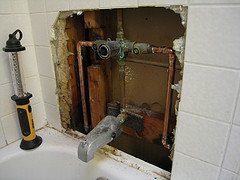Bathroom Shower Tile Repair
 Unless your family has very unusual hygiene habits, your shower tile will not have to stand up to wear and tear from heavy shoe traffic. However, it does face stresses of its own, especially large amounts of moisture. Prompt repair of tiles that are cracked or loose is essential, not only for the sake of your bathroom's appearance but also to keep water out of places where you absolutely don't want it -- your shower wall or subfloor.
Unless your family has very unusual hygiene habits, your shower tile will not have to stand up to wear and tear from heavy shoe traffic. However, it does face stresses of its own, especially large amounts of moisture. Prompt repair of tiles that are cracked or loose is essential, not only for the sake of your bathroom's appearance but also to keep water out of places where you absolutely don't want it -- your shower wall or subfloor.
Repair and Seal Shower Tile Grout
If the shower tile grout is loose, crumbling, or even missing in spots, moisture can easily penetrate into the wall. To repair, first clean the grout -- apply a vinegar-baking powder paste, let sit for 10 minutes, rinse, and let dry for a minimum of 24 hours. Alternatively, use a commercial grout cleaner. NOTE: Keep vinegar and other acids far away from natural stone tiles such as marble or travertine, as they will etch.
Patch or replace grout as necessary, matching the color to the existing grout as closely as possible. Next, you'll need to reseal the grout, if it is not epoxy-based. Roll or brush on a commercial grout sealant preparation, taking care to cover the entire surface of every grout line. Wait 24-72 hours before using the shower, depending on the instructions of the sealant manufacturer. For best results, inspect the condition of your shower grout regularly and reseal at least once every six months.
Repair Minor Shower Tile Cracks or Holes
A hairline crack or tiny hole in one or two of your shower tiles is just a minor mishap that can be fixed up with a simple tile repair -- replacement really shouldn't be necessary. To begin, make sure that the tile is dry. Follow up with the application of a thin line or a minuscule dab of waterproof paint or nail polish in the same shade as the shower tile, using a fine brush and a steady hand. Allow to dry thoroughly before turning on the shower.
Removal of Shower Tile
To repair tile that is seriously cracked or broken, you will have to remove the tile, the grout surrounding it, and the adhesive holding it in place. Work carefully to avoid damaging neighboring tiles that are still sound, as well as any waterproofing membrane that may be underlying the tile. Start by taking out the grout; then cautiously drill holes into the damaged tiles using a masonry bit. Break the tiling into small pieces and remove with the help of a chisel. Make sure that the underlying surface is clean and smooth. CAUTION: Wear protective eyewear and heavy work gloves to safeguard against sharp fragments of tile.
If it's necessary to take down any undamaged tile, first remove the grout, followed by gently working the tile(s) loose with a putty knife. Applying heat in the form of a hot iron can help to soften the adhesive.
Shower Tile Replacement
Best-case scenario: You deliberately ordered or otherwise ended up with extra pieces at the time of the shower tile install. Bathroom tile is not normally vulnerable to fading, so you should be able to insert a completely inconspicuous patch.
Otherwise: Go to your supplier with a piece, as complete as possible, of the tile which you just removed. Find the best match in terms of color, size, and shape. Remember to purchase a few spares this time for future tile repair jobs.
Additional options: Order new tiles custom-glazed to match the old ones, or choose a few contrasting tiles that will work as accent notes.
Laura Firszt writes for networx.com.
Updated May 13, 2018.
Related Articles
Looking for a Pro? Call us (866) 441-6648

Tile Contractors Experiences

Grout Replacement Made My Shower Look Brand New

Tile Backsplash Installation Turned Out Perfect



